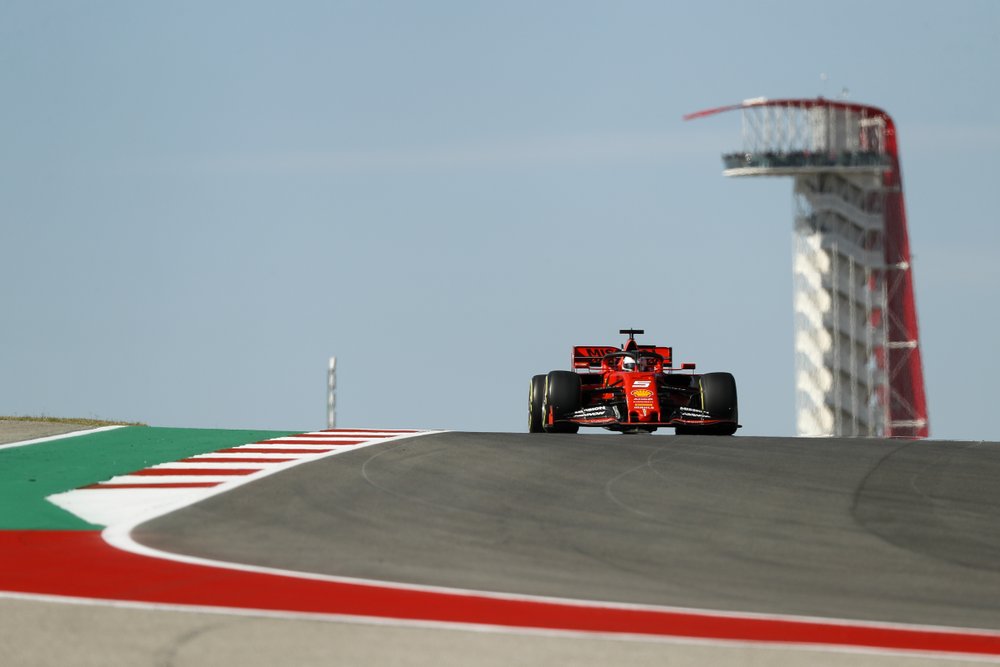
Ferrari driver Sebastian Vettel, of Germany, steers his car during first practice session for the Formula One U.S. Grand Prix auto race at the Circuit of the Americas, Friday, Nov. 1, 2019, in Austin, Texas. (AP Photo/Eric Gay
AUSTIN, Texas — Formula One officials have dreamed of expanding in the U.S. since the day the series returned to American soil in 2012.
Every step must feel like quicksand.
While American television ratings are rising and the U.S. Grand Prix in Texas has developed into a durable, popular race, dreams of landing F1 in other spots such as Las Vegas, Los Angeles and New York have never materialized. A planned 2021 Miami Grand Prix has run into fierce local resistance over worries about traffic disruptions, noise and air pollution without a corresponding economic impact.
“We’d be absorbing all the negatives and we wouldn’t be reaping any of the benefits,” Miami Gardens Mayor Oliver Gilbert III said. “I can’t imagine Formula One wants to have a race in a community where the residents don’t want them.”
The Miami Grand Prix was first proposed as a waterfront race with spectacular television views of cars zipping around Bayfront Park and the Port of Miami. But resistance from local neighborhoods scuttled that idea and the race evolved — or devolved — into a proposed course 25 miles north (and inland) in and near a parking lot at Hard Rock Stadium, home of the NFL’s Miami Dolphins.
The proposed course would include a couple of public streets near the stadium, leaving Miami Gardens to absorb road closures and days of school disruption for crowds that won’t be staying and spending their money locally, Gilbert said.
“We understand we are part of a larger economic ecosystem,” Gilbert said. ”(But) we’re a bedroom community. We don’t have the tourism infrastructure. (Race fans) will be staying in Miami Beach or Fort Lauderdale. They won’t be staying in Miami Gardens.”
At a lengthy Miami-Dade County commission meeting last Monday, the panel approved resolutions that would require another public hearing before the race could be approved, and another that could prevent closing of public streets for the race. The latter move could force course changes and confine the race to the stadium parking lot.
Formula One officials didn’t respond to requests for comment. Chairman and Chief Executive Officer Chase Carey told a group of F1 investors earlier this week the series recognized the new hurdles but is “still engaged” in trying to land the Miami Grand Prix.
A big part of F1′s struggles to stage a second U.S. race is finding a street course that is both acceptable to locals and logistically possible. That’s quite different from Texas.
While the proposed Miami race would run close to the front yards and playgrounds of the surrounding neighborhood, the U.S. Grand Prix races on a track built specifically for F1. The privately held Circuit of the Americas is several miles from downtown Austin and was built into the rolling hills and scrubland of Central Texas.
The surrounding community has slowly expanded toward the track, but the circuit remains mostly isolated near a landfill and businesses that include scrap yards and a recycling plant.
“You can stand on the side of (Hard Rock Stadium) and throw a rock into the neighborhood,” said Miami-Dade County Commissioner Barbara Jordan. To have a facility like the Texas track in South Florida, “you’d have to do it out in the Everglades, and that’s not going to happen.”
The U.S. Grand Prix faced some resistance when it was first proposed, mostly over objections to the $25 million in state money its collects annually and uses to pay F1′s fee to host the race. That money is available because the state Legislature made Formula One races eligible for the cash even before the U.S. Grand Prix race was revived in Texas.
“It’s not easy to pull one of these off,” Circuit of the Americas President Bobby Epstein said. “Unless you spend years and hundreds of millions on a place like this, you’re putting the sport in a place that was meant for something else.
“It’s hard to create a sustaining event in a parking lot,” Epstein said, adding he thinks F1 will find somewhere to stage a second race in the U.S.
Miami or elsewhere, Formula One is determined to expand its season.
Rules unveiled for 2021 and beyond allow up to 25 races in a calendar year. Carey has called Asia and the U.S. top targets for expansion. Miami would give F1 four events in North America, joining Texas, Montreal and Mexico City.
“I think it’s quality over quantity,” Carey said Thursday. “When we add a race in a place, we want to make sure it really brings something special to the sport.”